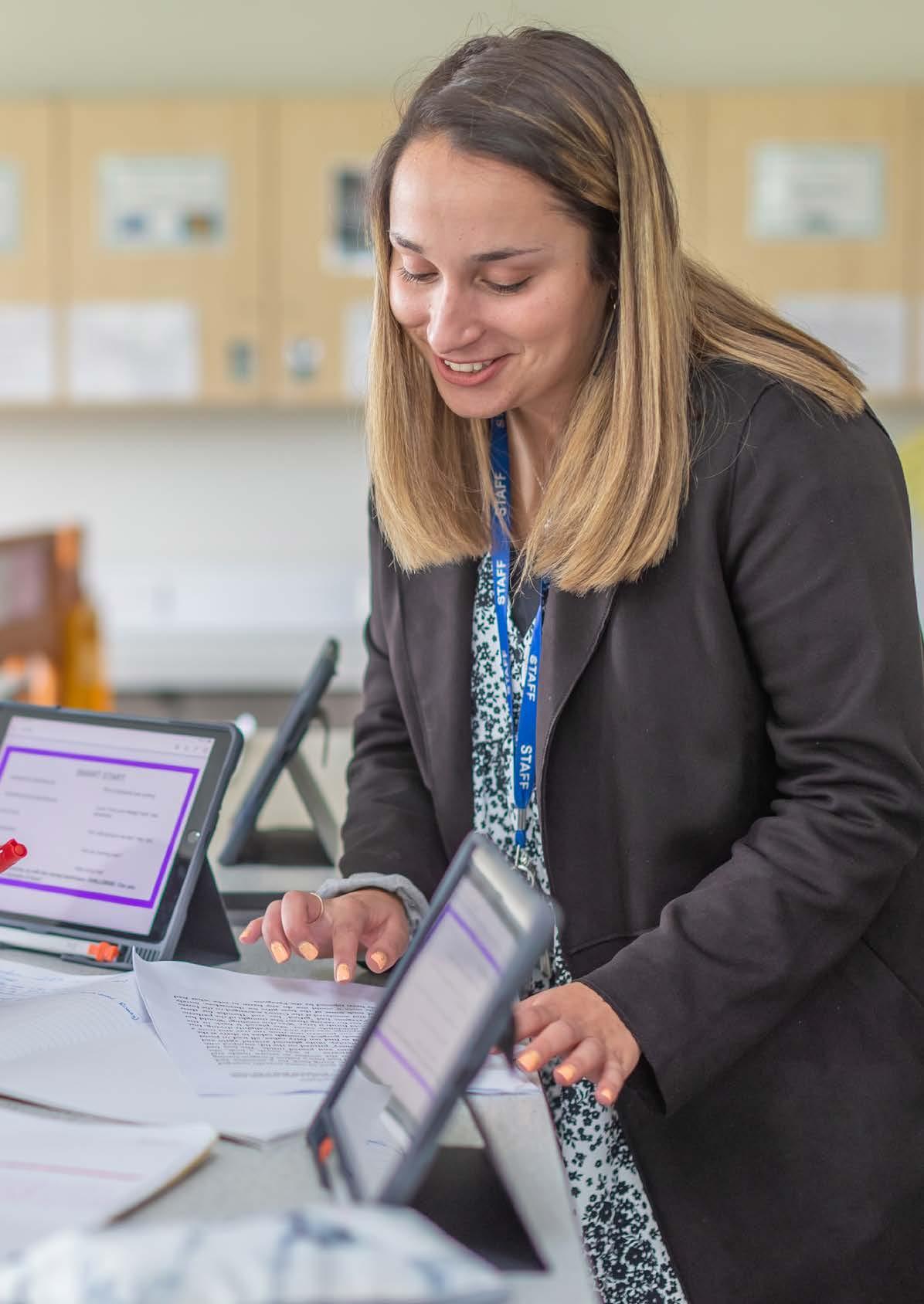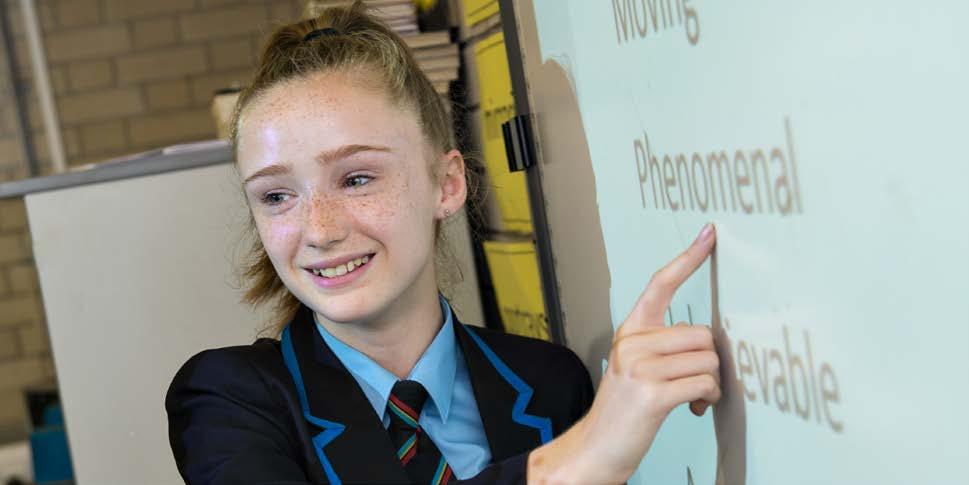




Aiming for 100%!






Aiming for 100%!
Brilliant basics are needed to establish a positive climate for learning in every classroom across our family. They set the tone for high expectations and high aspirations. In addition, they ensure that our teachers have everything they need to teach brilliantly and our students have everything they need to learn brilliantly.

Brilliant basics 1:
100% of classrooms across our schools are clean, tidy, clutter free and have displays that support learning and meet our world class standard.
Brilliant basics 2:
100% of classrooms have digital technology that works!
• Apple classroom is being used in 100% of lessons for years 7-9 so the teacher can monitor student work/screen use
• Projectors/visualisers are working and being used brilliantly by staff
• All students should be able to see the work that is being projected onto the board
• If a teacher is writing on the board, choose your colour carefully so that students can see and read what is being shared
Brilliant basics 3:
100% of students have access to key equipment/materials for each lesson (book organisation/presentation of student work)
All students have basic equipment (pens, pencils, rulers, glue sticks…)
• All students have their mini whiteboards/ mini whiteboard pens on the desk. Years 7-9 will have access to a whiteboard on their iPad via the WAT AFL app - video tutorial
• For years 7-9, all Google Classrooms should be set up using the following structure: video tutorial
• All students should have access to a laminated hard copy of the knowledge organiser. Years 7-9 will have an e-copy on their Google Classroom as well
• All students have access to subject resources (text books, novels…)
• Every piece of work in the students’ exercise book should have a clear title and date which is underlined using a ruler. The teacher should over communicate presentation expectations to students
Aiming for 100%!
Brilliant basics 4:
100% of students are engaging in learning
Lesson Starts
• The teacher is standing at the classroom door ready to greet students positively as they arrive. The teacher checks that uniform requirements are being met as students enter the room. Student monitors give out exercise books along with any other resources that are needed to support the learning in that lesson
• Students demonstrate that they are prepared for excellence and aspiring from the very start of the lesson by getting their desk organised and completing

their SMART START in silence. For years 7-9, the SMART START should be posted on Google Classroom in advance of the lesson.
• PFE is well embedded
• Apple classroom is being used effectively
• The class charts system is being used effectively. Catch the students aspiring and reward them!

Aiming for 100%!

Promoting whole class listening
• The teacher should never speak to the class while a student/students are speaking
• When the teacher needs to speak to the class, they should do so with a countdown ….. 3, 2, 1 and listening….Wait for 5 seconds and look around the room to ensure that all students are looking at you and have set their pens down. Make silent interventions using non-verbal cues where needed.
The end of lessons
• If a teacher has their own room, they should organise their key resources for the day as part of their morning routine when they arrive at school. Google Calendar can be a game changer for this: Video tutorial
• Students are asked to pack up 2 mins before the end of the lesson
• While the students are packing away, the teacher uses this opportunity to get sorted for the next lesson as well: wipe the board clean, ensure the teacher’s desk is tidy, sort key resources for the next lesson, make a comment in their teacher planner
• Student monitors know what they need to collect in for the teacher
• Students make sure that their area is left spotless
• Students stand behind their chairs in silence
• The teachers checks each row to ensure that expectations are met and then dismisses the class row by row (checking their uniform as they exit the room as well)
Microscript resource
Brilliant basics 5:
100% of classrooms have rigour and a thinkhard culture
• Lessons are planned using the high challenge for all scaffold
Cold calling, no opt out, stretch it and think-pair-share are consistently being used by all staff as a standardised part of our practice.


Let’s Codify!
100%
Lesson Starts Microscript
“Good morning year 7. It’s great to see you all again. Thank you for lining up one behind the other. We know our routine: Get organised and complete our SMART START in silence...thank you…”. Build in time to praise any students that have started the lesson really well. ‘’ Jimmy, you have started the lesson brilliantly, I can tell that you are organised and ready to ASPIRE’’. As soon as the final student enters the room, the teacher surveys the room and where appropriate, makes silent interventions using non-verbal cues (finger over the mouth to indicate silence, looking at a student and pointing to the the SMART START challenge on the board”

The end of lessons Microscript
“Ok everyone, let’s ASPIRE by taking responsibility for our work areas, it‘s time to pack away”. Provide a slow, deliberate countdown.
1. Pack away books (KS3) book monitors pack away books (KS4) and stationery away’
2. Tidy any rubbish away and stand behind your chairs
3. Check your uniform, check your area for any rubbish and wait silently to be dismissed
Promoting whole class listening Microscript
“Ok everyone, 3 - stop what we are doing”, pause and count to three in your head at this point, and then continue with saying “2 - put your pens down…” wait for the count of three again…”and 1….everyone looking at me”. Now wait and look around the room to ensure that you have 100% of students looking at you without anything in their hands. If you see a student still holding their pen for example, address this very discreetly by making eye contact with them and sharing a non-verbal gesture to set their pen down. When they do so, give them a thumbs up without saying anything to reinforce the positive.”
Codifying Number 5 - 100% of classrooms have rigour and a think hard culture


100% of classrooms have rigour and a think-hard culture

In order to make engaged participation the expectation, call on students regardless of whether they have raised their hands. Ask yourself “How can I adapt my decisions about which students I call on to help all students pay better attention?”
Benefits
1. Allows you to check for understanding effectively and systematically at any time whether or not the students are offerring to tell you.
2. Increases speed in both terms of your pacing and the rate at which you can cover material. No more waiting for students to offer up a response. Keep them on their toes and ready to answer at any time.
3. Allows you to distribute work more broadly around the room and signal to students that they are likely to be called upon to

participate and, therefore, that they should engage in the work of the classroom.
4. Helps to distribute work around the room, not only to those who always raise their hands but as an authority to reach out to individual students who need to be more engaged.
Strategy Basics
• Plan your questions carefully.
• Ask your question to the whole class. Give all students time to consider a response.
• Select a student to offer their response
100% of classrooms have rigour and a think-hard culture

Principles
1. Predictable: If you use Cold Calling a few minutes each and every day, students will come to expect it and change their behaviour in advance by paying attention and readying themselves mentally.
2. Systematic: Questions come at the students quickly, clearly and calmly, in clusters directed to multiple students, in multiple locations around the room, rather than focused on a single student or group of students in isolation.
3. Positive: Students do not volunteer because they do not think they can answer, but when forced to try, they are happily surprised to find themselves succeeding. Teachers must show respect and have faith in students and keep the atmosphere positive.

4. Scaffolded: Start with a simple question and progress to harder ones, drawing students in engaging them on terms that emphasize what they already know.
Don’t start your question with a student’s name, directing the question at an individual before the whole class has had time to think of a response. Doing so gives the rest of the class permission not to consider a response! Let them all consider a response before selecting a student to answer. It’s the anticipation of being asked that makes it effective on a whole class level.
• IRIS Examples (see videos 1 & 2) IRIS Clip 2
100% of classrooms have rigour and a think-hard


In a high-performing classroom, when a student says “I don’t know”, this is a cause for action. This is based on the high expectation that it is not ok to not try. Students need to know that when they say “I don’t know”, the teacher will strive to make the sequence end as often as possible with the student giving the right answer. If we do not take action, this sends a clear message to students that when they say “I don’t know” and we accept that response, we are giving them the green light to opt out of learning.
Benefits
1. It rehearses success and students get to hear themselves ‘getting it right’, building confidence and motivation.
2. It validates and honours students who know the answer by allowing them to help their peers in a positive and public way.
Strategy Basics
• Option 1 - When a student says that he does not know the answer to a question ask another pupil who does know the answer. You then ask the first pupil to repeat the answer to you again.
• Option 2 – When a pupil can’t answer the question, ask another pupil in the class to provide knowledge that is required to answer the original question. For example, if a pupil is unable to explain a disadvantage of ‘predatory pricing’, ask another pupil to explain what predatory pricing is first.
• Option 3 - Encourage them to refer to a resource that might support them e.g. a page reference in the knowledge organiser, the dictionary and so on. Give them some time to engage with the resource and then repeat the question. Praise their resilience.
100% of classrooms have rigour and a think-hard


1. There is less incentive to opt out than to have a go.
2. The teacher doesn’t spend a long time trying to squeeze an answer from a student, using ‘micro-questions’, who clearly doesn’t know or is determined in their refusal to answer. The pace of the lesson remains unaffected.
3. Upon receipt of a successful answer, follow-up questions can be used to add rigour; to raise the level of challenge or practise (see Stretch-It).
Accepting “I don’t know” with telling the student not to worry as we will phone a friend. The ‘friend’ answers the question correctly and student A has been allowed to opt out of learning.
• IRIS Clip 1 (from 2 mins)
• IRIS Clip 2
Teach Like a Champion: No Opt Out Field Guide
100% of classrooms have rigour and a think-hard


Key Idea
The teaching process does not end when a correct answer is given. Instead, the learning process continues and the reward for a correct answer is a more difficult question.
Benefits
1. Provided an additional level of highchallenge.
2. With consistent use, it builds a culture of high-challenge where students expect, even want, a follow-up question to demonstrate their understanding or extend their learning.
3. Ensures the reliability of correct answers when you follow-up with “how” or “why” questions. Students don’t get away with a lucky guess or a false positive.
4. Models an approach to lifelong learning; when a challenge is overcome, I welcome the next!
Strategy Basics
• Ask a question.
When the correct answer is provided, follow-up with a more-challenging question that requires the same individual to explain their answer or demonstrate a deeper understanding.
• As well as using subject specific, directive follow-up questions, use generic, nondirective phrases such as “how”, “why”, “keep going”, “say more” or “develop...”
Principles
1. Make a habit of asking follow-up questions to successful answers to develop a challenge culture.
2. Ask a diverse range of follow-up questions.
3. Use prompts such as “say more”, “keep going” or “develop...”

4. The strategy keeps students engaged, requiring them to think on their feet
5. Is an easy realisation of a differentiation strategy; you meet the students where they are now and push them a little further. That’s high challenge for all students!
6. Students often express themselves using the most simple language. To encourage the use of tier 3 vocabulary, follow-up an answer by asking students to “think of another word...”.
7. Stretch-it can reflect ‘reinforcement questions’ that keep existing skills and knowledge alive or ‘lateral stretching’ that moves the skillset or learning into a new area.
8. Stretch-it follow-up questions can be supported through non-verbal communication; nodding, hand gestures, raised eyebrows, etc. All can be used to

guide and encourage further development of a response.
9. Encourage students to stretch each other by training them to ask stretch-it type questions in paired and group work.
10. Over time, students will begin to automatically develop and provide deeper responses to your questions as a consequence of a stretch-it culture. Continuing to use stretch-it after this is where learning really accelerates.
• Teach Like A Champion Field Guide (Stretch-It, Wait Time... and Humility)
100% of classrooms have rigour and a think-hard


Key Idea
A questioning strategy to facilitate robust thinking in response to challenging, openended questions. Students work as an individual and then in pairs to develop thoughtful responses.
Benefits
1. Facilitates full engagement and participation.
2. Rebalances the teacher / student (cognitive) workload.
3. Encourages students to think more deeply, beyond surface level knowledge acquisition.
Strategy Basics
• Ask a thoughtfully designed, open-ended question.
• Give the students time to think. Not too much, but enough. Should be a silent task.
• Students pair up (or in threes) to share their individual thoughts and are given time to develop their thinking as a pair.
• Cold call on a student and ask them to share their paired response, possible leading to a brief class discussion.
• Use stretch-it follow-up questions to extend thinking and learning.

100% of classrooms have rigour and a think-hard culture

Principles
1. Talking and listening in a way that pushes thinking doesn’t come naturally; it needs to be taught.
2. As the students are considering their individual thoughts, prior to the pairing stage, the teacher has the opporttunity to circulate to check understanding and provide support.
3. It is important that the share stage is based upon cold calling. If students see you taking hands, they will see this as permission not to pair effectively in future.
Failure to use a cold-calling strategy in the share stage is the most common mistake. You don’t want to send the message that they don’t need to enage in the think stages as responding will be voluntary.

100% of classrooms have rigour and a think-hard culture Linking Strategies